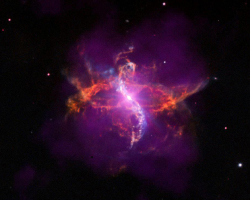HEAPOW: R Aqr Redux (2022 Mar 21)
Posted: Mon Mar 21, 2022 10:36 pm
 HEAPOW: R Aqr Redux (2022 Mar 21)
HEAPOW: R Aqr Redux (2022 Mar 21)
Symbiotic stars are parasitic binary systems composed of an evolved red giant star bound together with a dead, compact companion, usually a white dwarf. Gas from the red giant falls upon the compact object, is crushed by the strong gravity and heated, finally igniting in a thermonuclear blast by conversion of hydrogen into helium. This rejuvenates the white dwarf for awhile, and it once again produces energy. The variable star R Aquarii (R Aqr) is an intriguing example of stellar symbiosis where the history of past outbursts can still be seen as complex, spectacular structures surrounding the star. R Aqr is nearby (about 1200 lightyears away) so it's one of the best studied of all the symbiotic stars known. The image above is a composite false color image of the nebula around R Aqr seen in X-rays (from the XMM-Newton observatory) in purple along with an optical image from the Very Large Telescope. The optical image shows several bowl-shape cavities in the extended nebula around R Aqr. The X-ray emission seen by XMM is probably related to the wiggling jet from the white dwarf companion previously seen by the Chandra X-ray Observatory. Scientists believe that this jet is an ongoing feature emanating from the accretion disk around the white dwarf that helps clear out and heat up the outer ejecta, producing the extended X-ray emission seen by XMM-Newton. This is an important local case of how accreting systems "feedback" to their environments. Studying the ways in which R Aqr influences it environment helps astronomers understand the importance of feedback from accreting supermassive black holes at the centers of active galaxies on extragalactic scales.
ESA XMM-Newton: Inflating Bubbles with the Jet Feedback Mechanism in R Aquarii
An XMM-Newton EPIC X-Ray View of the Symbiotic Star R Aquarii ~ Jesús A. Toalá et al
- Astrophysical Journal Letters 927(1):L20 (2022 Mar 01) DOI: 10.3847/2041-8213/ac589d
- arxiv > astro-ph > arXiv:2203.02346 > 04 Mar 2022
viewtopic.php?t=42196
viewtopic.php?t=42201
| << Previous HEAPOW | High Energy Astrophysics Picture of the Week | Next HEAPOW >> |